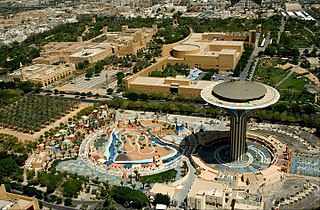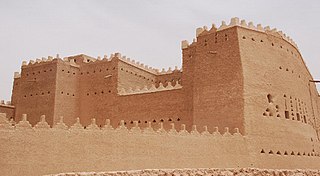This is a list of museums in Saudi Arabia.
This is a list of museums in Saudi Arabia.



Riyadh is the capital and largest city of Saudi Arabia. It is also the capital of the Riyadh Province and the centre of the Riyadh Governorate. The current state of the city emerged as an offshoot of the eponymous walled town following the dismantling of the defensive fortifications in the 1950s.

Jeddah, alternatively transliterated as Jedda, Jiddah or Jidda, is a port city in Makkah Province, Saudi Arabia, located along the Red Sea coast in the Hejaz region. Jeddah is the commercial center of the country. It is not known when Jeddah was founded, but Jeddah's prominence grew in 647 when the Caliph Uthman made it a travel hub serving Muslim travelers going to the holy city of Mecca for Islamic pilgrimage. Since those times, Jeddah has served as the gateway for millions of pilgrims who have arrived in Saudi Arabia, traditionally by sea and recently by air.

Ḥaʼil Province, also known as the Ha'il Region, is one of the 13 provinces of the Kingdom of Saudi Arabia. It is the eighth-largest province by area at 103,887 km2 (40,111 sq mi) and the ninth-largest by population, with the population in 2019 being 731,147. The province accounts for roughly 2% of the population of the country and is named for its largest city, Ha'il. Other populous cities in the province include al-Ghazalah, Shinan and Baq'aa. The region is famous for the twin mountain ranges of 'Aja and Salma, and for being the homeland of historic symbol of curiosity and generosity, Hatim al-Ta`i.

Haʼil is a city in north-western Saudi Arabia. It is the capital and largest city of Ha'il Region, with a population of about 498,575 (2022).

Kharj is a governorate in central Saudi Arabia. It is one of the important governorates in the Kingdom of Saudi Arabia and is located in the southeast of the capital Riyadh, within an area of 19,790 km2 ~ 4,890,215.5 acres, and a population of 376,325 people, according to the statistics of the General Authority for Statistics for the year 2010. The city of Al Saih is the capital of modern Kharj and its administrative and economic center.

The Masmak Fort, also called the Masmak Fortress or Masmak Palace, is a clay and mudbrick fort in the al-Dirah neighborhood of Riyadh, Saudi Arabia, located in close proximity to the al-Hukm Palace in the Qasr al-Hukm District. Built in 1865 for prince 'Abdurrahman ibn Sulaiman AlDabaan under the Emirate of Jabal Shammar, The fortress played an integral role in the Unification of Saudi Arabia, with the Battle of Riyadh, one of the most important conflicts of the Saudi unification, taking place in the fort. Since 1995, the fortress has been converted into a museum showcasing one of the most important landmarks of Saudi heritage.

Dawadmi or Ad Dawadimi is a town in Riyadh Province, Saudi Arabia. Google Maps spells the name as Al Duwadimi. As of the 2022 census it had a population of 86,861 people. The town is mostly inhabited by the tribe of Banu 'Utaybah.

Articles related to Saudi Arabia include:

Saudi Arabia is the second biggest tourist destination in the Middle East with over 16 million visiting in 2017. Although most tourism in Saudi Arabia still largely involves religious pilgrimages, there is growth in the leisure tourism sector. As the tourism sector has been largely boosted lately, the sector is expected to be the white oil for Saudi Arabia. This is proved as tourism sector is expected to generate $25 billion in 2019. Potential tourist areas include the Hijaz and Sarawat Mountains, Red Sea diving and a number of ancient ruins.
Hussa bint Ahmed Al Sudairi was one of the wives of King Abdulaziz of Saudi Arabia, with whom she had seven sons and four daughters. Her sons included two future Saudi kings, Fahd and Salman, as well as Sultan bin Abdulaziz and Nayef bin Abdulaziz, who both later served as crown prince. Her sons with Abdulaziz are commonly known as the Sudairi Seven.

King Abdulaziz Historical Center(KAHC) (Arabic: مركز الملك عبدالعزيز التاريخي) is a cross-district heritage complex in Riyadh, Saudi Arabia, covering south of al-Murabba and north of al-Futah. It includes the al-Murabba Palace, the National Museum, King Abdulaziz Foundation for Research and Archives, King Abdulaziz Public Library, King Abdulaziz Auditorium, Red Palace and Riyadh Water Tower besides six municipal parks and gardens, namely the National Museum Park, al-Watan Park, the Palm Oasis and al-Yamamah Park. It was inaugurated in January 1999 by King Fahd bin Abdulaziz to mark the centenary year of Ibn Saud's takeover of Riyadh in 1902, that paved the way for the establishment of the Emirate of Riyadh, the first iteration of modern Saudi Arabia.

The Khuzam Palace is a major palace and museum in Jeddah, Saudi Arabia. It houses the Jeddah Regional Museum of Archaeology and Ethnography.
Al Hawiyah is a town in Makkah Province, located 15 km from Ta'if. It was a small suburb in the past. Currently it has expanded to include more than 15 residential neighborhoods, with an area of 80 km2 and is inhabited with many different classes of Saudi society. The population of Al Hawiya in 2010 was about 200,000 according to the last national census. Nowadays, Al Hawiyah is considered as an emerging vibrant area with many government facilities. And currently known as North of Ta'if city.
The following is a Gregorian timeline of the history for the city of Riyadh, Saudi Arabia.

The Murabba Palace is one of the historic buildings in Al Murabba, Riyadh, Saudi Arabia. The palace is the first building that was erected outside the walls of the old city. It was named after its square with the form of 400 by 400 metres. It is one of the museums in the city.
The King Abdulaziz Center for World Culture(Ithra) (Arabic: مركز الملك عبد العزيز الثقافي العالمي), also known as Ithra, is a cultural situated in Dhahran, Saudi Arabia. It was built by Saudi Aramco and inaugurated by King Salman bin Abdulaziz on December 1, 2016.

At-Turaif is a historic district located in Al-Dir'iyah, north-west of Riyadh. It is regarded as one of the more important political and historical sites in Saudi Arabia, as it represented the capital of Saudi dynasty. It was the original home of the Saudi royal family and was the country's first capital from 1727 until Ottoman control of the area in 1818.
Below are Museums in Riyadh. The Riyadh region in Saudi Arabia is characterized by having a massive number of historical and heritage monuments and museums, which represent the successive civilizations that left these traces on the area.

Museum culture within Saudi Arabia can be traced back to 1945, when the Kingdom participated in the founding of the United Nations Educational Scientific, and Cultural Organisation (UNESCO) and signed the Cultural Treaty of the Arab League which emphasizes, in Article 10, the need to focus on the field of antiquities in the Arab world. Plans for museums began at the first archaeological conferences held by the Arab League Educational, Cultural, and Scientific Organisation (ALESCO).

Downtown Riyadh is a term used for a group of 20 neighborhoods in Riyadh, Saudi Arabia. Covering an area of more than 3700 acres, it hosts some of the city's most important cultural and commercial districts, such as the King Abdulaziz Historical Center, the al-Batʼha commercial area and the Qasr al-Hukm District, while simultaneously overlapping with many of the old city areas of the capital metropolis, including the erstwhile walled town. The first downtown development plan was introduced in 2013 by the Royal Commission for Riyadh City.